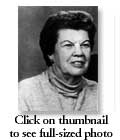Autumn Keltner
Senior Research Associate
Comprehensive Adult Student Assessment System
(CASAS)
1992-Present
Director, SLIAG Model Transition Project, 1991-1992
Consultant, Amnesty Education Office
California Department of Education
1986-1991
San Diego Community College District, Continuing Education Centers
District Coordinator of ABE and ESL programs, 1972-1986
Instructor Coordinator, Project Step Up1970-1972
ABE and ESL Instructor, 1960-1970
San Diego Unified School district
ABE and ESL Instructor, 1953-1960
Instructor, Fourth Grade, 1947-1950
Interviewed by : Cuba Miller
Date: April 16, 1999
MILLER: Well, the second wave came two or three years later. [Chuckling] Can you describe the refugees that came in the second wave, in terms of social skills and literacy levels?
KELTNER: Mostly Cambodian fishermen and/or Lao Hmong hill people, most of whom had had little or no education whatsoever in their own countries. The Lao Hmong did not even have much of a written language to learn to read their own language, had not even been exposed much to print material in any way. Many of them did not even realize that if you put a piece of paper in front of you, that was something you should be getting … could be getting meaning from. So it was a major, major difference in teaching that had to be brought in immediately.
MILLER: We didn't have many teachers that were capable of teaching that pre-literacy level either.
KELTNER: That's very true. We had never been exposed to doing that kind of thing. And then, of course, these people also had not been exposed to living in a city, they knew nothing about using sanitary facilities, kitchen equipment, rest room facilities. So there was a whole other area where they had to have instruction to be able to learn how to cope with the things in a city.
MILLER: Or what clothes were appropriate to wear.
KELTNER: Everything related, because you either had people who'd lived on the rivers or people who'd lived in the hills.
MILLER: So, Autumn, bringing someone in at that level, the Hmong hill … how many years of instruction before they would reach an intermediate level of what we call basic competency?
KELTNER: Unfortunately, some never did, never have. Many of them learned fairly quickly the basic rudiments of language and were able to cope at, I would say, a beginning to high beginning level, and plateaued, and are still trying to master beyond that today. Many, particularly with the Hmong, moved into the Central Valley, and that area is still heavily impacted, high unemployment for that population. Now the second-generation coming along seems to be doing very, very well, no problem. But for [those original] people and the shock to their lives, I think it was just such a culture shock and a mental shock to them that they weren't able to cope with it.

